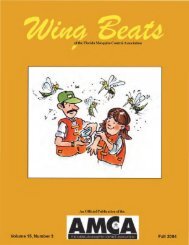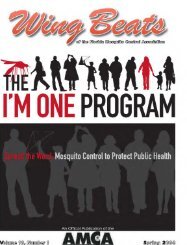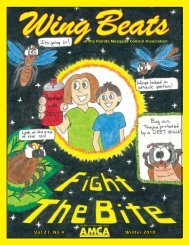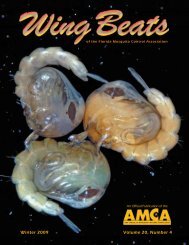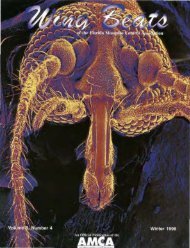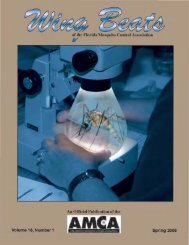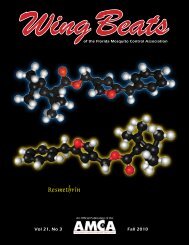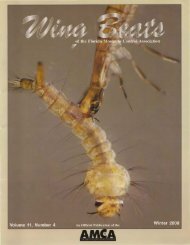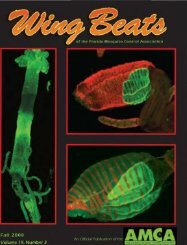Volume 23 Number 1 - Wing Beats - Wing Beats - Florida Mosquito ...
Volume 23 Number 1 - Wing Beats - Wing Beats - Florida Mosquito ...
Volume 23 Number 1 - Wing Beats - Wing Beats - Florida Mosquito ...
You also want an ePaper? Increase the reach of your titles
YUMPU automatically turns print PDFs into web optimized ePapers that Google loves.
46<br />
connected to a body of water<br />
or applications of pesticides to<br />
an intermittent stream when it<br />
is dry requires an NOI (Notice<br />
of Intent). According to EPA, the<br />
answer is “no” in both instances.<br />
Nonetheless, concerns remain<br />
because of several Agency<br />
initiatives involving potential increases<br />
in of numbers and types<br />
of waters subject to Clean Water<br />
Act jurisdiction. For instance,<br />
The House Science, Space, and<br />
Technology Committee has just<br />
asked the Environmental Protection<br />
Agency to provide more<br />
information about an EPA draft<br />
study of biological, chemical<br />
and physical connections between<br />
ephemeral, perennial,<br />
and intermittent waters and<br />
wetlands and larger navigable<br />
waters. This study is being reviewed<br />
at the same time the<br />
White House Office of Management<br />
and Budget (OMB) has<br />
begun reviewing Clean Water<br />
Protection Guidance, which was<br />
developed jointly by EPA and<br />
the US Army Corps of Engineers<br />
to clarify the scope of federal<br />
protection over US waters.<br />
As proposed in May 2011, the<br />
guidance would expand federal<br />
jurisdiction and permitting<br />
requirements to include many<br />
intermittent and ephemeral<br />
streams and wetlands not covered.<br />
Such OMB reviews are<br />
generally required to be completed<br />
within 90 days but the<br />
final guidance could be released<br />
within the next 30 days.<br />
The guidance, crafted jointly<br />
with the Army Corps of Engineers,<br />
is expected to generally<br />
expand CWA jurisdiction over<br />
tributaries to traditionally<br />
navigable waters, wetlands<br />
adjacent to those tributaries<br />
and other marginal waters by<br />
offering a new interpretation of<br />
when discharges to these waters<br />
are subject to regulation. The<br />
proposed joint guidance was<br />
issued after years of confusion<br />
over how to interpret two<br />
US Supreme Court decisions<br />
on what constitutes waters of<br />
the United States and after<br />
previous guidance attempted<br />
to interpret these cases [Solid<br />
Waste Agency of Northern Cook<br />
County v US Army Corps of Engineers<br />
(SWANCC), 531 US 159,<br />
51 ERC 1838 (2001); Rapanos<br />
v United States, 547 US 715, 62<br />
ERC 1481 (2006)]. Justice Antonin<br />
Scalia stated that only “relatively<br />
permanent” waters that hold a<br />
“continuous surface connection”<br />
to a traditionally navigable<br />
water of the United States can<br />
be considered jurisdictional,<br />
whereas Justice Anthony Kennedy<br />
opined that waters sharing<br />
a “significant nexus” with jurisdictional<br />
water bodies can be<br />
subject to CWA regulations as<br />
well. As you can see, it needs<br />
clarification and, in my view, a<br />
narrow interpretation.<br />
Muddying the waters, so to<br />
speak, even further is the remarkable<br />
variation in state<br />
permits when compared to the<br />
EPA Pesticide General Permit<br />
(PGP). This may prove problematic<br />
if legal challenges<br />
are forthcoming. According to<br />
Rebeckah Adcock, senior director<br />
of government affairs for<br />
CropLife America, if a citizen’s<br />
lawsuit alleges that a state’s<br />
permit is not the equivalent of<br />
the PGP, the EPA has indicated<br />
that “that’s your permit and<br />
you’re going to have to defend<br />
it.” She thinks it will take longer<br />
than the February 29 beginning<br />
of enforcement for suits to surface,<br />
and I agree, “because the<br />
activist community will want to<br />
seek out states and/or patterns<br />
in a particular case that work<br />
most in their favor.”<br />
As of the date of this writing,<br />
Charles Tebbutt, the attorney<br />
Spring 2012 <strong>Wing</strong> <strong>Beats</strong><br />
whose suit forced EPA to issue<br />
the permit, would not indicate<br />
whether he or other environmentalists<br />
will sue either the<br />
states, districts or EPA. Nevertheless,<br />
Tebbutt has stated that “…<br />
the EPA pesticide permit is very<br />
weak, and say at this point very<br />
much favors industry.” Tebbutt<br />
remains unconvinced that increased<br />
resource requirements<br />
to meet the NPDES mandates<br />
will adversely affect the provision<br />
of vector control services,<br />
echoing other activists opinions<br />
that says those fears are baseless.<br />
Pest control methods are<br />
broader than pesticide application,<br />
he says, and in cases<br />
where pest control districts have<br />
been compelled to limit their<br />
use of pesticides, the impacts<br />
on human health or the spread<br />
of disease have been negligible.<br />
“The whole thing with West<br />
Nile virus and the ability to spray<br />
or not is really just fear mongering,”<br />
Tebbutt said. “Again, this<br />
is the chemical industry driving<br />
the process so they don’t lose<br />
sales, is the basic fact here.”<br />
Welcome to the activist mindset<br />
and rationale for imposition of<br />
the NPDES. You’d better hope<br />
and work to see that HR 872<br />
gets debated and passed, for<br />
activist attorneys will no doubt<br />
inexorably push for increasingly<br />
restrictive regulation – and judicial<br />
interpretations are the<br />
means to get it.<br />
Joseph M Conlon<br />
AMCA Technical Advisor<br />
conlonamcata@gmail.com<br />
1500 Millbrook Court<br />
Fleming Island, FL 32003<br />
904-215-3008



